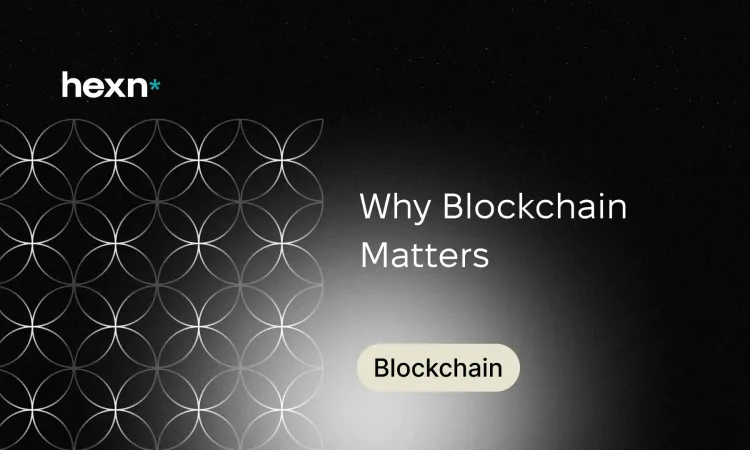Why Blockchain Matters
Blockchain is a distributed digital ledger that records information across many computers so entries cannot be changed easily. It matters because it enables trusted transfers of value and data without relying on a single central authority, opening new options for finance, record-keeping, and secure digital services.
- Distributed ledger technology spreads records across nodes to reduce single points of failure.
- Immutability and cryptography make it difficult to alter past entries, helping preserve data integrity.
- Broad applications include digital currencies, programmable contracts, tokenized assets, identity systems, and supply chain tracking.
How Blockchain Stores Information
At a basic level, a blockchain groups validated transactions into blocks. Each block holds transaction data, a timestamp, a unique cryptographic hash, and a reference to the previous block. Linking blocks by hashes creates a chain where changing one block would require redoing all subsequent blocks, which is intentionally costly and difficult.
Two cryptographic tools are central to this security model. Hash functions turn any input into a fixed-size fingerprint; a tiny change to the input produces a dramatically different output. Public-key cryptography gives each participant a private key to sign transactions and a public key others can use to verify those signatures, so only the owner of a private key can authorize moves of assets associated with that key.
What Happens When you Send a Transaction
1. Creating and broadcasting the transaction
A user signs transaction details with their private key and broadcasts the signed message to the network so nodes can see the proposed transfer.
2. Validation and grouping into blocks
Network nodes check the transaction against protocol rules. Valid transactions are collected into a candidate block along with other verified transactions and metadata like timestamps.
3. Agreement and block addition
A consensus process determines which candidate block is accepted and appended to the chain. When a block is accepted, its transactions become part of the permanent ledger that all honest nodes copy and maintain.
4. Linking and propagation
The accepted block contains the previous block's hash, so it becomes part of the immutable chain. The updated chain is propagated across the network so all nodes converge on the same history.
How Decentralized Networks Reach Agreement
A consensus mechanism is the rule set that allows distributed participants to agree on the ledger's state even when some participants are unreliable or malicious. Different mechanisms trade off security, speed, and resource use.
Proof of Work (PoW)
PoW requires participants to perform computational work to propose a block. The work is resource-intensive and helps secure the network because altering history would require redoing enormous amounts of computation.
Proof of Stake (PoS)
In PoS systems, validators are chosen to create blocks based on how much value they have committed to the protocol as collateral. Stakes align incentives: misbehavior can lead to slashing of the staked funds.
Other Models and Hybrids
There are many alternatives and hybrids, such as delegated systems where token holders elect a smaller set of block producers, or identity-based models that rely on known, trusted validators for faster processing in permissioned settings.
Blockchain Types and Who Uses Them
Public Blockchains
Public networks are open for anyone to join and participate in validating and reading data. They prioritize censorship resistance and broad transparency.
Private Blockchains
Private or permissioned ledgers restrict participation to approved parties. Organizations use them for internal workflows where access control and performance matter more than full decentralization.
Consortium Blockchains
Consortium models sit between public and private: a group of organizations jointly governs the network, sharing control and maintaining a common ledger for business-to-business use cases.
Common Real-World Use Cases
Digital Currencies and Cross-Border Payments
Blockchains serve as the underlying ledger for digital currencies, enabling peer-to-peer transfers and cheaper, faster cross-border settlement compared with many traditional rails.
Smart Contracts and Decentralized Finance
Programmable contracts run on blockchains to automate agreements and financial services. Decentralized finance (DeFi) uses those primitives to offer lending, trading, and other services without traditional intermediaries.
Tokenization of Assets
Real-world assets such as real estate, art, or financial instruments can be represented as digital tokens, improving divisibility and potentially unlocking new liquidity and fractional ownership models.
Digital Identity and Voting Systems
Blockchains can anchor verifiable digital identities and provide auditable, tamper-evident voting records that increase transparency and reduce opportunities for manipulation.
Supply Chain Transparency
Recording provenance events on a ledger helps track goods through production and distribution, making it easier to verify origin, reduce fraud, and streamline recalls.
Why Blockchain Is Useful for Fintech and Beyond
- Decentralization: No single entity controls the ledger in fully permissionless systems.
- Transparency: Participants can inspect the same shared data, improving accountability.
- Immutability: Confirmed records are difficult to change retroactively.
- Security: Cryptographic primitives protect data and authenticate actors.
- Efficiency gains: Removing intermediaries can reduce friction and cost for many processes.
Final Thoughts
Blockchain is not a one-size-fits-all solution, but it provides a different set of trade-offs compared with centralized systems. Its combination of distributed record-keeping, cryptographic security, and programmable logic enables new business models and services. As the technology matures, expect continued innovation in how organizations use blockchains to solve real problems in finance, logistics, identity, and governance.
